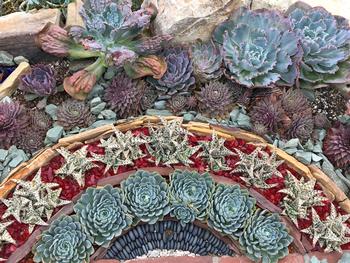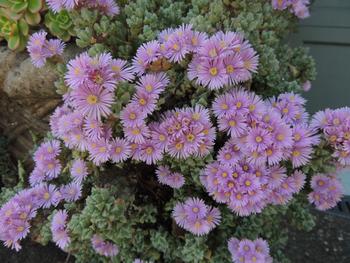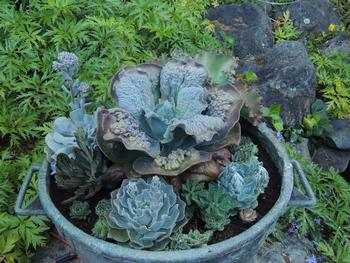Succulents are excellent low-water-use plants
-
Diane Lynch
-
There was a time when I turned up my nose at succulents. But somewhere along the way, I started looking more closely and realized that they are amazingly varied, beautiful, and dramatic. Now they are everywhere in my garden, including the shady parts. I started by putting a few in my many pots and have gradually filled most with them as I’ve stopped planting annuals, which require so much diligent watering. I added crushed lava rock to potting soil to improve drainage.
 Succulents can be arranged into works of art as this bed in a SoCal botanical garden illustrates. Photo: Diane Lynch
Succulents can be arranged into works of art as this bed in a SoCal botanical garden illustrates. Photo: Diane LynchSucculents are plants that store water in their leaves, roots, or stems. This actually describes most plants, but succulents are often differentiated by the fact that their leaves tend to be puffy, and this water storage allows them to survive drought. Can you kill them by not watering at all? Yes, but it will take a while as most are forgiving of ideal care, and they will get by on much less water than many commonly grown plants. Many thrive in well-drained containers. If you haven’t received the word from MMWD, you’ll be in for a rude surprise with coming water rates, which are set to skyrocket to about 60% higher over the next few years. Fewer lawns are likely what our future will look like.
Cacti are also succulents, often defined by their spines, which are modified leaves. They don’t have leaves, but rather the pads associated with cacti are modified stems, allowing them to photosynthesize and survive the most extreme conditions. Cacti are succulents, but not all succulents are cacti. Lampranthus deltoides produces bright pink blooms. Photo: Diane Lynch
Lampranthus deltoides produces bright pink blooms. Photo: Diane LynchHere’s another thing about succulents: free plants! Aeoniums, for example, are super easy to propagate by taking cuttings and letting the cut ends dry off before shoving them into a pot or the garden. Some, such as Echeverias, will send out “pups,” which can be separated from the mother plant and planted on their own. Bryophyllums, a type of Kalanchoe, even develop tiny plantlets along the leaf margins, which drop off to grow new plants. Graptopetalum can root from a single leaf stem left in contact with soil. Who doesn’t like free plants?
Succulents will get by on much less maintenance than the average lawn-centered landscape with annuals or flowering shrubs. Less deadheading, mowing, watering, and fertilizing mean more time and money saved for other endeavors. Succulents will benefit from occasional dividing and replanting, but you can do this on your schedule. This winter, my Aeoniums went crazy with all the rain and need some cutting back. I’ll put the cuttings in a box with a sign on it for neighbors to take. I particularly like Aeoniums, which look like Dr. Seuss plants to me, and come in an amazing array of colors ranging from pale yellowy green to black.
From a design standpoint, succulents are beautifully sculptural and lend themselves to interesting arrangements either in garden beds or pots. These can range from a single specimen plant to a dozen or more plants nestled into a beautiful container. Cuttings are great for a potted arrangement on an outdoor table. When they get too leggy, liberate them into the garden. This large copper pot is a handsome container for succulents. Photo: Diane Lynch
This large copper pot is a handsome container for succulents. Photo: Diane LynchThe Marin Master Gardeners have been busy propagating succulents for their sale on June 3 behind the greenhouse at Falkirk, 1408 Mission Avenue, San Rafael, from 9 AM to Noon. Please bring cash or checks, no credit cards. You can see photos of the list of available plants at https://plantmaster.com/presents/plants.php?id=643631392ada7.
While you’re at Falkirk, take some time to meander around the gardens near the beautiful old greenhouse. The Master Gardeners have spent years planting and tending these demonstration gardens to inform the public. You may come up with great ideas for using succulents in your garden.



